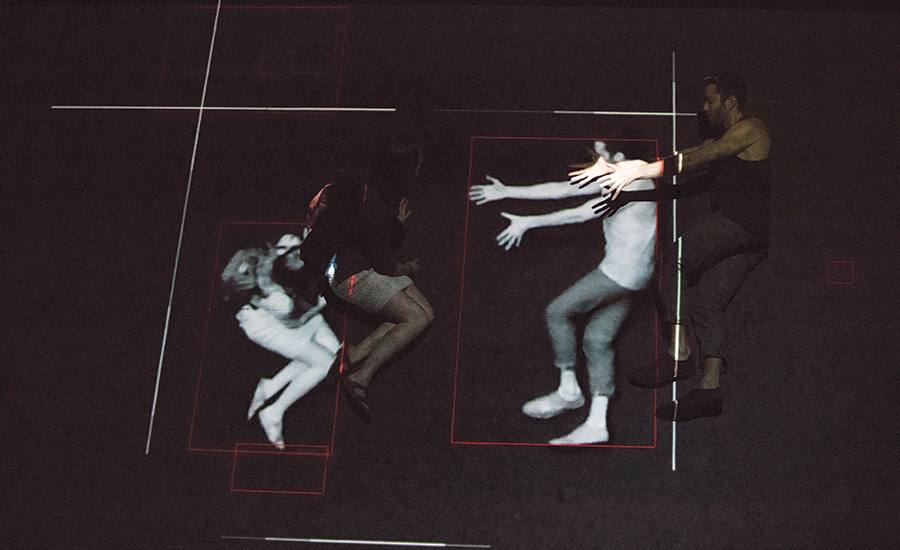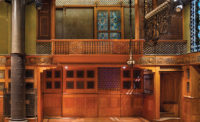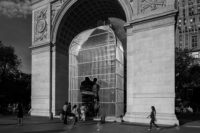The Chinese artist-activist Ai Weiwei is nothing if not connected. All through the introductory remarks at the press preview for Hansel & Gretel, the giant art installation about electronic surveillance at the Park Avenue Armory in New York (open through August 6), Ai was busy on his phone. When cocurator Tom Eccles turned from the project’s other two collaborators, the Pritzker Prize–winning architects Jacques Herzog and Pierre de Meuron, giving Ai the cue to speak, the artist looked up and without missing a beat chimed in with the wittiest and possibly most substantive remark of the preview. As Herzog and de Meuron had been bandying the success rate of the exhibition’s digital facial-recognition technology about—the estimates rising from 40 to 50, then 60 percent—Ai wryly added that the Chinese government’s accuracy rate is 150 percent.
Hansel & Gretel—the latest in the Armory’s series of huge Drill Hall extravaganzas, whose title indicates that we all leave breadcrumb trails, whether we want to or not—is another collaboration among Mr. Ai and Mssrs. Herzog and de Meuron. They’ve worked together on and off for 15 years on such projects as the Bird’s Nest stadium for the 2008 Olympics in Beijing and, in 2012, the Serpentine Gallery in Kensington Gardens in London. Herzog & de Meuron, moreover, is the architectural firm in charge of the ongoing $210 million renovation of the 19th-century Park Avenue Armory building itself.
Part 1 of this technology-rich dystopian spectacle occupies the whole of the darkened 55,000-square-foot Drill Hall, which the audience enters not from the Armory’s grand, staircased main entrance, but through an inconspicuous rear door on Lexington Avenue. (Herzog and de Meuron wanted to punch a kind of guerilla entry into that brick wall, but the idea was nixed.) Once inside, visitors make their way through almost pitchblack corridors to a ramp that takes them up a few feet to the main attraction: a floor on which are projected their surveilled overhead images, which follow them around like digital puppy dogs. The images come from dozens of overhead cameras, not the tethered drones buzzing around overhead. The phenomenon undoubtedly inspires awe in a few (“awe” was mentioned by the designers as the principle desired effect), but to anyone who’s watched one of the Toms—Cruise or Hanks—trying to flee a crew of totally wired bad guys, those illuminated brackets accompanying moving targets are all too familiar.
Getting to Part 2 involves exiting the Drill Hall through another door on Lexington, turning a corner, and hoofing it down the block to the main entrance on Park Avenue. Upon entering, you’re photographed and your face is matched with surveillance photos that were taken surreptitiously in the Drill Hall. (My match turned out not to be me but a handsomer guy a few seats down at the iPad table where visitors see—or, 40 percent of the time, fail to see—their cover blown.)
Part 2, in a much smaller area of the Armory called the Head House, is much the better part of Hansel & Gretel. It’s less glamorous— simply furnished with big wood tables at which visitors can sit. There they can see how well they’ve been spotted in the Drill Hall, as well as peruse the best item in the show: a timeline of surveillance techniques and events from ancient Egypt (“eyes of the Pharoah,” aka spies) through the proto-computer Turing Machine that broke the Nazis’ “Enigma” code and to weaponized drones currently in use in Afghanistan.
Hansel & Gretel seems made to order for middle-school kids on a field trip; they always find special effects in the dark totally cool. (At $15 a ticket, bringing them in would require a drastically reduced group rate.) The Drill Hall gizmopalooza gives everyone a visceral experience of what it’s like to be watched by unseen forces, and the Head House didactics fill in details about the making of the installation. The problem with the exhibition is that in spite of—or perhaps because of—the expensive light show (the Armory won’t say how much it all cost), its insights into the power and meaning of surveillance are superficial. There’s not much beyond a general vibe that electronic surveillance is bad—and this emanates mostly from from Ai’s history of persecution by the Chinese government. Meanwhile, every time there’s a terrorist attack in the West, pundits wonder why the culprits weren’t more thoroughly and continuously surveilled. The lesson of Hansel & Gretel is that a convincing work of art addressing the conundrum of civil liberties versus public safety can’t merely be a funhouse ride in the shadows.







Post a comment to this article
Report Abusive Comment